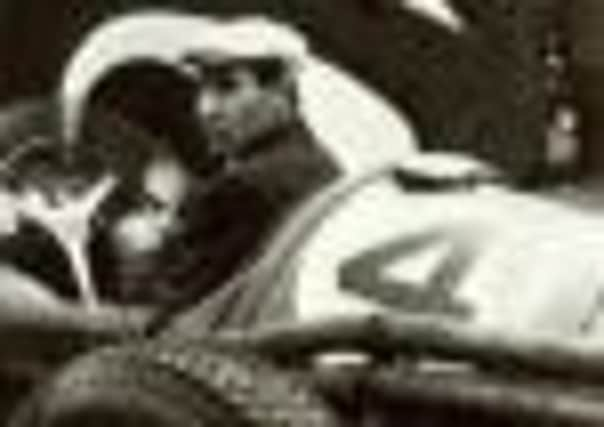Obituary: Roy Salvadori; racing driver who won Le Mans and co-drove with Jim Clark


ROY Salvadori was one of the great British racing drivers of the 1950s and Sixties, the romantic era of Stirling Moss, Mike Hawthorn and Tony Brooks which paved the way for British success in the sport thereafter.
Although best-known as one of the pioneer Formula 1 drivers from 1952-62, he never won a Grand Prix, but finished second in the 1958 German GP, third in the British GP at Silverstone in his Cooper-Climax and fourth in the overall drivers’ championship that year behind Hawthorn, Moss and Brooks. Although he was born in England, Salvadori’s parents were Italian and his dark, dashing good looks and somewhat exotic name epitomised the romance of the motor racing of the time, an era when drivers raced in primitive helmets, if any, and used simple wooden steering wheels.
Advertisement
Hide AdAdvertisement
Hide AdIn 1959, his name entered the record books of big race winners. Sharing a dark green David Brown Aston Martin DBR1 with American sports car-builder Carroll Shelby, Salvadori won the historic 24 hours race at Le Mans, leaving the mighty Ferraris in his wake. (A young Scot called Jim Clark came tenth in his first time at Le Mans.) With another DBR1 finishing in second, Aston Martin went on to win that season’s World Sports Car Championship.
The following year (1960) Salvadori was poached by a Scottish racing team, the Border Reivers – from the Berwick-Duns area – to share a Le Mans drive with Clark. The Border Reivers’ founder, garage owner Jock McBain from the Chirnside area, had been impressed by Salvadori’s 1953 second place in the Nurburgring 1,000km race, sharing a Jaguar C-Type with Edinburgh’s Ian Stewart for a rival Scottish racing team, David Murray’s Ecurie-Ecosse. That team, famed for its cars’ Saltire blue metallic paint, would go on to nurture the talents of drivers such as Ninian Sanderson, Jimmy Stewart (no close relation to Ian) and later Jimmy’s wee brother (now Sir) Jackie.
McBain helped persuade pre-war racing driver and post-war team manager Reg Parnell to run an Aston Martin DBR1 at the 1960 Le Mans race, in the Border Reivers’ colours, to be driven by Salvadori and Clark.
The team had to restore the car, burnt out at Goodwood the previous year, but the pair finished a creditable third behind two Ferrari 250s. The Le Mans race was the highlight and peak of The Border Reivers’ history; McBain died in 1961, aged only 50, and the team was wound up.
Roy Francesco Salvadori was born on 12 May, 1922 in the seaside Essex village of Dovercourt. He went to school in and around London before joining his father’s refrigeration firm during the war, a business restricted by his father’s status as an “enemy alien” after Italy backed Hitler. After the war, young Roy flourished and focused on his love of motor. At the age of 24, he began selling cars on London’s Warren Street, later opening a garage in Tolworth, Surrey.
After discovering the need for speed in an R-Type MG and a Riley, he laid his hands on a 2.9 litre Alfa Romeo P3 sports car whose “one previous owner” was said to have been Italy’s pre-war racing legend Tazio Nuvolari. Salvadori entered it in the Grand Prix des Frontières at Chimay, Belgium, and finished fifth, even though his car got stuck in top gear. In 1949, he wrote off his own Maserati at the Curragh track in Ireland, and in 1951 he had a serious accident in his Frazer-Nash at the Daily Express Silverstone meeting. It was in 1953 that he began his long association with the Aston Martin works team. In 1955, he drove a Maserati 250F to victory in the Glover Trophy at Goodwood and the Daily Telegraph Trophy at Aintree, as well as to second place in the Daily Express Trophy at Silverstone.
In 1957, BRM signed him up for their F1 team, but he was unhappy with the handling of their cars. After failing to qualify for the Monaco Grand Prix, he quit the team and concentrated on racing Aston Martin sports cars and Cooper F2 cars. After Cooper started to run “oversize” two-litre F2 cars in F1 races, he had his best season in 1958, with those podiums in Germany and Silverstone.
After a 130 mph crash in a race in Australia, Salvadori suffered partial paralysis to his face. He quit F1 in 1962, but continued to race sports and touring cars and was lucky to escape from his Jaguar 3.8 after a puncture sent it somersaulting into a lake at Oulton Park. After quitting all competitive driving in 1965, he helped develop the Ford GT 40 before managing the Cooper F1 team for several years. He then ran his own motor business before retiring with his wife Susan to Monte Carlo, where his flat overlooking the Grand Prix finish line was a party magnet for drivers at GP time every year.
PHIL DAVISON